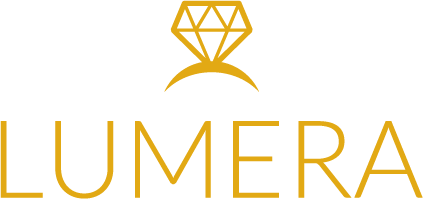Contact
Click below to speak to a Diamond Consultant or customer service.
or
Live Chat8:00 am - 6:00 pm CST (Mon - Fri)

Click below to speak to a Diamond Consultant or customer service.
or
Live Chat8:00 am - 6:00 pm CST (Mon - Fri)

The round cut diamond is the most popular diamond shape, representing approximately 75% of all diamonds sold. Due to the mechanics of its shape, the round diamond is generally superior to fancy diamond shapes at the proper reflection of light, maximizing potential brightness.
Virtually all round diamonds are brilliant-cut, meaning they have 58 facets (57 when there is no culet).

Choose from our assortment of hand matched Diamond Stud Earrings set in 14k gold.
Round diamonds cost more on a per carat basis than fancy shapes for two reasons; the demand for round diamonds is very high, and the yield is relatively low. Because more of the rough stone is lost in the cutting of a round diamond, the cost of each carat retained is higher. A typical round diamond (for example; a 1.00 carat, F-color, VS2-clarity, Ex cut) may cost 25-35% more than a similar fancy shape.
The round diamond began to rise in popularity in 1919 with the publication of Marcel Tolkowsky's thesis "Diamond Design: A Study of the Reflection and Refraction of Light in Diamond". Tolkowsky's work described the ideal proportions of a round cut diamond for maximizing light return (or brilliance) and dispersion (or fire). The original Tolkowsky specifications (53% table, 59.3% depth, 34.50 crown angle, visible culet) have since been modified as the cut mechanics for round diamonds have perfected over time. These theoretical advancements, as well as advancements in technology (such as the use of lasers in diamond cutting), have been adopted by diamond manufacturers to produce the incredibly brilliant cuts we see today in well cut round diamonds.
The table below serves as a general guideline for evaluating the cut of a round diamond. GIA takes these and other factors into consideration when assigning a cut grade.
| EXCELLENT | VERY GOOD | GOOD | FAIR | POOR | |
|---|---|---|---|---|---|
| Table % | 53 - 58 |
52 - 53
or 58 - 60 |
51
or 61 - 64 |
50
or 65 - 69 |
< 50
or > 69 |
| Depth % | 59 - 62.3 |
58 - 58.9
or 62.4 - 63.5 |
57.5 - 57.9
or 63.6 - 64.1 |
56.5 - 57.4
or 64.2 - 65 |
< 56.5
or > 65 |
| Crown Angle | 34 - 34.9 |
32.1 - 33.9
or 35 - 35.9 |
30.1 - 32
or 36 - 37.9 |
29 - 30
or 38 - 40.5 |
< 29
or > 40.5 |
| Pavilion Depth | 42.8 - 43.2 |
42 - 42.7
or 43.3 - 43.9 |
41 - 41.9
or 44 - 45.5 |
39 - 40.9
or 45.6 - 48 |
< 39
or > 48 |
| Girdle |
Thin
to Sl. Thick |
Very Thin
to Sl. Thick |
Very Thin
to Thick |
Very Thin
to Very Thick |
Ex. Thin
to Ex. Thick |
| Culet | None | Very Small | Small | Medium | > Medium |
| L/W Ratio | 1.00 - 1.01 | 1.02 | > 1.02 | ||
Evaluating color in round cut diamonds is subjective. Keep in mind that many customers may actually prefer the ever so slightly warmer colors of a G-H diamond over the cool colorlessness of a D-F diamond. In fact, most of the premium in price associated with round diamonds at the higher end of the color scale is driven by supply and demand; customers want the D-F color grades, and are willing to pay a premium to get them. In a world without diamond color grading, the price premium for higher grades would be much lower, as the actual differences in color are difficult to perceive. The color chart below provides a general guide for evaluating color in round diamonds.
| EXCELLENT | VERY GOOD | GOOD | FAIR | POOR | |
|---|---|---|---|---|---|
| < .50 ct. | D - G | H - I | J - K | L - M | > M |
| .51-1.0 ct. | D - G | H - I | J - K | L - M | > M |
| 1.0-2.0 ct. | D - F | G - H | I - J | K - L | > L |
| > 2.0 ct. | D - F | G | H | I - J | > J |
| Fluoro | None | Faint - Med | Strong | Very Strong | |
Like color, evaluating clarity in round diamonds is subjective. GIA provides excellent help with their clarity grades. Still, it is important to understand that each customer will have a unique standard for clarity. Some may be perfectly comfortable with an inclusion as long as they cannot easily see it. Others may insist on a more technically flawless appearance. The clarity chart below provides a general guide for evaluating clarity in round diamonds.
| EXCELLENT | VERY GOOD | GOOD | FAIR | POOR | |
|---|---|---|---|---|---|
| < .50 ct. | FL - VS2 | SI1 - SI2 | I1 | I2 | > I2 |
| .51-1.0 ct. | FL - VS1 | VS2 - SI1 | SI2 | I1 - I2 | > I2 |
| 1.0-2.0 ct. | FL - VVS2 | VS1 - VS2 | SI1 - SI2 | I1 | > I1 |
| > 2.0 ct. | FL - VVS2 | VS1 - VS2 | SI1 | SI2 | > SI2 |
Questions about shape or other aspects of a diamond? Ask a diamond consultant for answers. A consultant will answer any questions you have, and if you like, search for diamonds on your behalf that match your criteria. chat online, or email [email protected].

